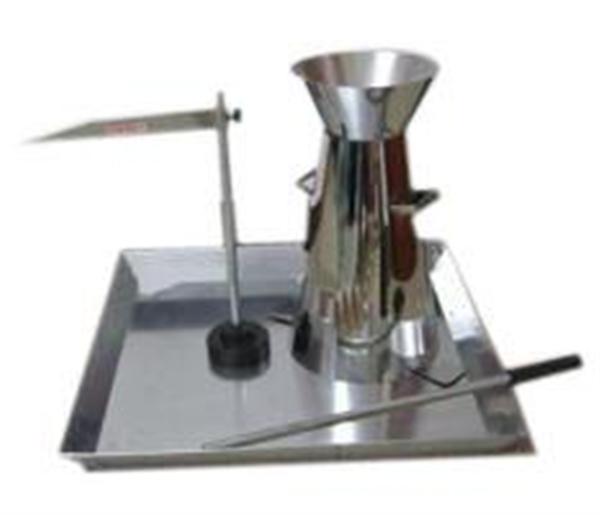Product Name:
Stainless Steel Slump Test Device
Stainless Steel Slump Test Device
Method of Operation
1. First, dampen the slump cylinder, iron shovel, mixing board, and other tools with a wet cloth. The slump cylinder is in a conical shape, with an upper diameter of 100mm, a lower mouth diameter of 200mm, and a height of 300mm.
2. Weigh the materials according to the mix ratio: first weigh the cement and sand, then pour them into the mixing board. Mix thoroughly on the board, then add the aggregate. Use a shovel to stir the center of the pile, and pour half of the required water. Mix well, then add the remaining water and continue mixing until the mixture is uniform. The total mixing time should be around 4–5 minutes.
3. Place the slump cylinder on a non-absorbent rigid plate, position the funnel above it, and step on the pedal to begin filling. Fill the mixture in three layers, each approximately one-third the height of the cylinder. Insert the tamping rod from the edge to the center in a spiral pattern, 25 times per layer, without impact. Distribute the material evenly across the interface. When inserting the bottom layer, ensure the rod reaches the full depth. For the next two layers, insert the rod 20–30mm into the previous layer.
4. After filling, trim the excess mixture with a straightedge and smooth the top surface. Remove any concrete around the base of the cylinder. Lift the slump cylinder slowly within 5–10 seconds, ensuring no lateral or torsional forces are applied. The entire process from loading to removing the cylinder should take no more than 150 seconds.
5. Position the slump cylinder next to the concrete sample, place a ruler across the top of the cylinder toward the mixture. Measure the vertical distance from the bottom of the ruler to the highest point of the sample using a steel ruler. This measurement is the slump of the concrete, accurate to 1mm, and rounded to the nearest 5mm. If the sample collapses or shears during the test, retest. If the issue persists, the concrete may be too difficult to handle and should be noted.
6. When the slump exceeds 220mm, measure both the maximum and minimum diameters of the spread concrete. If the difference between the two is less than 50mm, use the average as the slump spread value. Otherwise, the test is invalid. The slump spread is measured to the nearest 1mm and rounded to the nearest 5mm.
Coin/Button Cell - Holders, Thru-Hole and Surface Mount
Lithium Coin Cell Battery Holders
Coin Battery Holder・Coin Cell Holder・Button Cell Holder (CR498・ CR503・CR1058・CR1220・CR1225・CR1620・CR1632・CR2016・CR2032・CR2330 ・CR2430・CR2450・CR2477)
These holders are manufactured from UL rated 94V-O materials. Contacts made of high quality spring steel to assure reliable connections and allow contact resistance. Each contact is clearly marked with its polarity to assure proper battery insertion.
Lightweight and rugged, these PCB coin cell holders offer uniquely designed notched battery slot that assures quick and easy insertion and replacement of all major battery manufacturers' lithium coin cells.
Availability is from stock through Keystone's Global Distributor Network. Application engineering services are available to meet special customer requirements.
DESIGN ADVANTAGES
Low profile for high density packaging
Reliable spring tension contacts assure low contact resistance
Retains battery securely to withstand shock and vibration
Rugged construction, light weight
Compatible with vacuum and mechanical pick & place systems
Base material UL rated 94V-0. Impervious to most industrial solvents
Clearly marked polarities to help guard against improper insertion
Coin Cell Holders,Coin Cell Battery Holders,Coin Battery Holders
HuiZhou Antenk Electronics Co., LTD , https://www.atkconn.com
